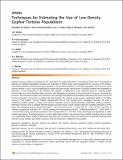Files in this item
Techniques for estimating the size of low-density gopher tortoise populations
Item metadata
| dc.contributor.author | Stober, Jonathan M. | |
| dc.contributor.author | Prieto-Gonzalez, Rocio | |
| dc.contributor.author | Smith, Lora L. | |
| dc.contributor.author | Marques, Tiago A. | |
| dc.contributor.author | Thomas, Len | |
| dc.date.accessioned | 2018-11-12T12:30:06Z | |
| dc.date.available | 2018-11-12T12:30:06Z | |
| dc.date.issued | 2017-12-01 | |
| dc.identifier | 255606712 | |
| dc.identifier | 19e23785-eb05-40be-8c15-78791ebff7cc | |
| dc.identifier | 85038865330 | |
| dc.identifier | 000418056300004 | |
| dc.identifier.citation | Stober , J M , Prieto-Gonzalez , R , Smith , L L , Marques , T A & Thomas , L 2017 , ' Techniques for estimating the size of low-density gopher tortoise populations ' , Journal of Fish and Wildlife Management , vol. 8 , no. 2 , pp. 377-386 . https://doi.org/10.3996/012017-JFWM-005 | en |
| dc.identifier.issn | 1944-687X | |
| dc.identifier.other | ORCID: /0000-0002-7436-067X/work/54818842 | |
| dc.identifier.other | ORCID: /0000-0002-2581-1972/work/56861247 | |
| dc.identifier.uri | https://hdl.handle.net/10023/16434 | |
| dc.description | Partial support by CEAUL (funded by Fundação para a Ciência e a Tecnologia, Portugal, through the project UID/MAT/00006/2013) (TAM). | en |
| dc.description.abstract | Gopher tortoises (Gopherus polyphemus) are candidates for range-wide listing as threatened under the U.S. Endangered Species Act. Reliable population estimates are important to inform policy and management for recovery of the species. Line transect distance sampling has been adopted as the preferred method to estimate population size. However, when tortoise density is low, it can be challenging to obtain enough tortoise observations to reliably estimate the probability of detection, a vital component of the method. We suggest a modification to the method based on counting usable tortoise burrows (more abundant than tortoises) and separately accounting for the proportion of burrows occupied by tortoises. The increased sample size of burrows can outweigh the additional uncertainty induced by the need to account for the proportion of burrows occupied. We demonstrate the method using surveys conducted within a 13,118-ha portion of the Gopher Tortoise Habitat Management Unit at Fort Gordon Army Installation, Georgia. We used a systematic random design to obtain more precise estimates, using a newly developed systematic variance estimator. Individual transects had a spatially efficient design (pseudocircuits), which greatly improved sampling efficiency on this large site. Estimated burrow density was 0.091 ± 0.011 burrows/ha (CV = 12.6%, 95% CI = 0.071–0.116), with 25% of burrows occupied by a tortoise (CV = 14.4%), yielding a tortoise density of 0.023 ± 0.004 tortoise/ha (CV = 19.0%, 95% CI = 0.016–0.033) and a population estimate of 297 tortoises (95% CI = 210–433). These techniques are applicable to other studies and species. Surveying burrows or nests, rather than animals, can produce more reliable estimates when it leads to a significantly larger sample of detections and when the occupancy status can reliably be ascertained. Systematic line transect survey designs give better precision and are practical to implement and analyze. | |
| dc.format.extent | 10 | |
| dc.format.extent | 2990155 | |
| dc.language.iso | eng | |
| dc.relation.ispartof | Journal of Fish and Wildlife Management | en |
| dc.subject | Abundance | en |
| dc.subject | Burrows | en |
| dc.subject | Cluster size analysis | en |
| dc.subject | Gopher tortoise | en |
| dc.subject | Line transect distance sampling | en |
| dc.subject | Population density | en |
| dc.subject | Systematic sampling | en |
| dc.subject | QH301 Biology | en |
| dc.subject | QL Zoology | en |
| dc.subject | Animal Science and Zoology | en |
| dc.subject | Ecology, Evolution, Behavior and Systematics | en |
| dc.subject | Ecology | en |
| dc.subject | Nature and Landscape Conservation | en |
| dc.subject | NDAS | en |
| dc.subject.lcc | QH301 | en |
| dc.subject.lcc | QL | en |
| dc.title | Techniques for estimating the size of low-density gopher tortoise populations | en |
| dc.type | Journal article | en |
| dc.contributor.institution | University of St Andrews. Statistics | en |
| dc.contributor.institution | University of St Andrews. School of Mathematics and Statistics | en |
| dc.contributor.institution | University of St Andrews. Scottish Oceans Institute | en |
| dc.contributor.institution | University of St Andrews. Centre for Research into Ecological & Environmental Modelling | en |
| dc.contributor.institution | University of St Andrews. Marine Alliance for Science & Technology Scotland | en |
| dc.identifier.doi | https://doi.org/10.3996/012017-JFWM-005 | |
| dc.description.status | Peer reviewed | en |
This item appears in the following Collection(s)
Items in the St Andrews Research Repository are protected by copyright, with all rights reserved, unless otherwise indicated.

